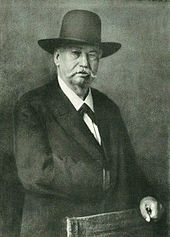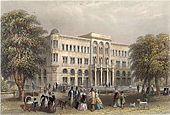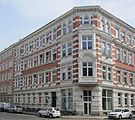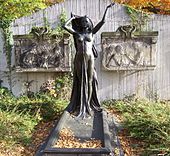Willmar Schwabe
Carl Emil Willmar Schwabe (* 15. June 1839 in Auerbach / Vogtl. , † 8 January 1917 in Leipzig ) was a particularly in the field of homeopathy active pharmacist , author and founder of the company.
Live and act
As the son of a pharmacist, Willmar Schwabe did an apprenticeship as a pharmacist in Dresden , then studied at Leipzig University from 1861–1863 and received his doctorate in 1863 as a pharmacist. In the course of his studies, he studied the teachings of Samuel Hahnemann and became a staunch supporter of homeopathy. Schwabe was 1863-1865 administrator (administrator) of the homeopathic dispensing facility of the unified pharmacies in Leipzig "Homeopathic Central Pharmacy Täschner & Co.", which was founded in 1849 in the dispensing dispute .
In 1865 he was made a district doctor in Leipzig, and in the same year he applied to open his own homeopathic company, which the city council allowed him to do. In 1866 (according to other sources, 1865), at the age of 26, he founded the Homeopathic Central Officin Dr. Willmar Schwabe , in which homeopathic mother tinctures were made as the basis for later medicines. They were delivered to other pharmacies and abroad. At the same time he founded his own publishing house for homeopathic literature with a printer. From this officially approved “wholesale and import business of homeopathic products”, today's Dr. Willmar Schwabe GmbH & Co. KG and the German Homeopathy Union .
After a few arguments, Schwabe was given permission to open a homeopathic pharmacy on February 17, 1871 in the former Centralhalle An der Pleiße 3 b (today Dittrichring / corner of Gottschedstraße), where medicines were also given to patients: the Homeopathic Central Pharmacy to Samuel Hahnemann . In 1878 he succeeded in acquiring the “Homeopathic Central Pharmacy” at Thomaskirchhof 12, where he had worked for two years as an administrator, and thus eliminated the only competition in Leipzig. From now on it traded under the Homöopathische Central-Apotheke Dr. Willmar Schwabe . In 1882 the company moved to Querstraße 5. It stayed there until 1926, when it moved to the new factory in Paunsdorf Bahnhofstraße (from 1928 Breitingstraße 54).
Schwabe quickly fought for an almost unrestricted monopoly. The first two domestic branches were opened in 1891, and the first depot abroad (Amsterdam) in 1895. In 1900 there were 50 branches worldwide, in 1913 around 750 and in 1926 more than 2500 branches. The quality of the drugs sold by Schwabe contributed not least to the company's success. Schwabe was enthusiastic about homeopathy, the careful and conscientious production was important to him. In addition, his journalistic endeavors contributed to the success, as he also published medical specialist literature in his publishing house. In 1872 his self-written standard work, Pharmacopoea Homoeopathica Polyglottica , was published, which, after heated discussions, was accepted by the Central Association of Homeopathic Doctors as a binding pharmacopoeia and in 1934 was also officially recognized as the German Homeopathic Pharmacopoeia . In addition, Schwabe published more than 200 other works, including the sixth edition of the Organon published by Richard Haehl , the authoritative basic work of homeopathy, and Rudolf Tischner's history of homeopathy . In addition, there were specialist books and advisory literature as well as magazines, including the Allgemeine Homöopathische Zeitung from 1910 to 1939 . He offered the homeopathic lay associations club pharmacies at special rates and supported their lecture evenings.
Schwabe was a co-founder and from 1892–1904 also chairman of the joint local health insurance fund for Leipzig and the surrounding area . The street in which the newly built administration building of the local health insurance fund was opened in 1925 was named on August 15, 1925 in memory of the “pioneer in the social insurance of the German workers”. In addition, Schwabe founded a private outpatient clinic in Leipzig in 1871 , where patients were treated on an outpatient basis and homeopathic doctors were trained. He also bought two manors in 1889 (the Gleesberg estates near Schneeberg and Förstel near Langenberg ) and in 1896 the Augustusbad spa near Radeberg in order to initially make them available as recovery stations free of charge, but in 1904 in the Dr. Willmar Schwabeschen Heimstätten Foundation and transfer it to the Leipzig local health insurance fund.
In 1870 Schwabe married Luise Eder, the eleven years younger daughter of his former trainer in Dresden. The couple had four daughters and one son. In 1879 Schwabe acquired a large piece of land on Kohlgartenstrasse in the then still independent municipality of Reudnitz near Leipzig. Here he had a splendid family seat built. A large park-like garden with a pond, a large fountain, a tennis court and various other gardens was connected to the north of the villa, which is still standing today. A large part of it is now the public Elsapark . On the north-western border of the property, on Konstantinstrasse, he built six five-storey apartment buildings from 1887 to 1891.
Schwabe was also involved in many ways outside of his company. As early as the 1870s he was a member of the Leipzig city council. In the 1880s he was a member of the community council of his place of residence Reudnitz and from 1890 to 1895 an unpaid city councilor in Leipzig.
After a short illness, Willmar Schwabe died on January 8, 1917 at the age of 78. He was buried at the New Johannisfriedhof in Leipzig at the side of his wife. After the New Johannisfriedhof was closed, the grave design was transferred to the Old Johannisfriedhof.
honors and awards
- Commerce Council
- Privy Councilor
- Saxon Albrechts Order, 1st class
- Prussian Crown Order III. class
The company after 1945
After the company moved to the western part of Germany in 1946 (to Karlsruhe-Durlach), the Leipzig business was nationalized in 1948, and in 1952 it was transferred to VEB Homeopharm - Dr. Willmar Schwabe and converted into VEB Leipziger Arzneimittelwerk (LAW) in 1957 . In 1970 it was incorporated into the VEB Kombinat Arzneimittelwerke Dresden , where the Leipziger Arzneimittelwerk became a legally independent collective enterprise from 1978.
After the political change, the company on Elisabeth-Schumacher-Strasse in Paunsdorf (formerly Breitingstrasse) was converted into Leipziger Arzneimittelwerk GmbH in 1990 , which was taken over by the Wyeth Group in 1992 . In 2000, Riemser Arzneimittel AG took over the Leipziger Arzneimittelwerk, and in 2013 it was sold to the Prange Group.
In the former homeopathic central pharmacy at Thomaskirchhof, which closed on December 31, 1996, there is now the Saxon Pharmacy Museum Leipzig, which opened on July 17, 1999 on the initiative of the Saxon Pharmacists' Association, together with a restaurant in the historic pharmacy interior .
The company group around the Karlsruhe-based Dr. Willmar Schwabe GmbH & Co. KG is still owned and managed by Schwabe's family, now in the fifth generation. The Heimstätten Foundation was also retained by his heirs as the Schwabesche Heimstätten operating company . In 2001 she was able to take over Gut Gleesberg again and set up a nursing home there.
Mention in fiction
The adventure novelist Karl May , popular in the 20th century, describes in his travel story Through the Desert and Harem , which was renamed Through the Desert in 1895 , that he, as his alter ego Kara Ben Nemsi in Cairo, had a “still half-filled homeopathic pharmacy from Willmar Schwabe come into my hand ”. He describes how he successfully used a "box with aconite, sulfur, pulsatilla and all the remedies that are to be had in a pharmacy of a hundred numbers" "here and there with a stranger or acquaintance five grains of the thirtieth potency" and thus would have gained the reputation of a successful doctor.
Works
- Pharmacopoea homoeopathica polyglotta . Schwabe, Leipzig 1872 ( digitized version )
- Pharmacopoea homoeopathica polyglotta . Schwabe, 2nd edition, Leipzig 1880 ( digitized version )
- German Homeopathic Pharmacopoeia: List and description of homeopathic medicinal products, together with instructions for their preparation, testing and value determination . Schwabe, 3rd edition, Leipzig 1906 ( digitized version )
- German Homeopathic Pharmacopoeia: List and description of homeopathic medicinal products, together with instructions for their preparation, testing and value determination . Schwabe, 4th edition, Leipzig 1908 Digitized edition of the University and State Library Düsseldorf
- Homeopathic Pharmacopoeia: List of homeopathic medicinal products together with instructions for their preparation, testing and value determination . Schwabe, 2nd German edition of the Pharmacopoea homoeopathica polyglotta, Leipzig 1929 Digitized edition of the University and State Library Düsseldorf .
literature
- Eckhard Hansen, Florian Tennstedt (Eds.) U. a .: Biographical lexicon on the history of German social policy from 1871 to 1945 . Volume 1: Social politicians in the German Empire 1871 to 1918. Kassel University Press, Kassel 2010, ISBN 978-3-86219-038-6 , p. 146 f. ( Online , PDF; 2.2 MB).
- Christian Heermann : New aspects and open questions in the Karl May biography. In: Yearbook of the Karl May Society 1990. Hamburg 1990, pp. 132-146 ( online ; Karl May mentioned Willmar Schwabe's products in some of his works).
- Volker Jäger: In the service of health. On the history of Willmar Schwabe. In: Medicine, Society and History. Vol. 10 (2001), pp. 171-188.
- City of Karlsruhe (Ed.): Street names in Karlsruhe (= Karlsruhe contributions. No. 7). Karlsruhe 1994, ISBN 3-7650-0407-3 ( online ).
- Gina Klank, Gernot Griebsch: Lexicon of Leipzig street names . Leipzig 1995, ISBN 3-930433-09-5 (source for dates of birth and death).
- Michael Michalak: The homeopathic medicine. From the beginnings to industrial production (= Heidelberger Schriften zur Pharmazie- und Naturwissenschaftsgeschichte. Vol. 5). Stuttgart 1991, ISBN 3-8047-1174-X (dissertation, University of Heidelberg, 1990).
- Holm-Dietmar Schwarz: Schwabe, Willmar. In: New German Biography (NDB). Volume 23, Duncker & Humblot, Berlin 2007, ISBN 978-3-428-11204-3 , pp. 778 f. ( Digitized version ).
Web links
- Pharmacist and manufacturer . Article by Christoph Friedrich in the Pharmazeutische Zeitung on the 100th anniversary of Willmar Schwabe's death (January 2017).
- Finding aid for inventory 20706 Willmar Schwabe Arzneimittel Leipzig, in the Leipzig State Archives
Individual evidence
- ↑ On his work as the head of the health insurance company, cf. Collection of sources on the history of German social policy from 1867 to 1914 , III. Department: Expansion and differentiation of social policy since the beginning of the New Course (1890-1904) , Volume 5, The statutory health insurance , edited by Wolfgang Ayaß , Florian Tennstedt and Heidi Winter, Darmstadt 2012, pp. 210, 245, 566, 585, 594 f., 619, 625, 627, 636, 667.
- ↑ Augustusbad - It used to be so beautiful. Heimatverein Liegau-Augustusbad, accessed on March 29, 2018 .
- ↑ Neustädter Markt Journal 2/2008, pp. 8–12 (online)
- ↑ LAW website
- ↑ Karl May : Through the desert p. 79ff.
| personal data | |
|---|---|
| SURNAME | Schwabe, Willmar |
| ALTERNATIVE NAMES | Schwabe, Carl Emil Willmar (full name) |
| BRIEF DESCRIPTION | Homeopath, pharmacist, author and company founder |
| DATE OF BIRTH | June 15, 1839 |
| PLACE OF BIRTH | Auerbach / Vogtl. |
| DATE OF DEATH | January 8, 1917 |
| Place of death | Leipzig |





